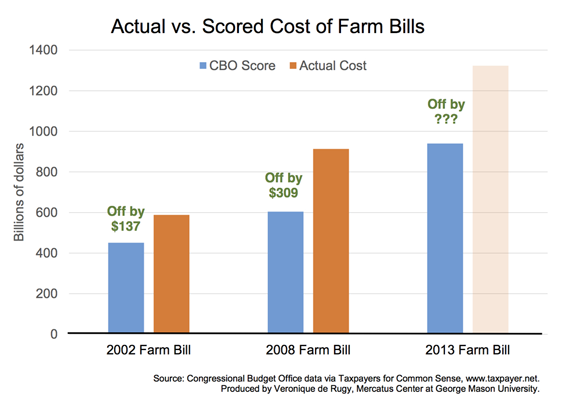- | Government Spending Government Spending
- | Data Visualizations Data Visualizations
- |
CBO Scoring of Farm Bills vs Actual Costs
Despite the recent defeat of the farm bill in the House, it is worth keeping in mind that when proposed in Congress, the 2013 farm bills cost nearly $1 trillion over ten years yet were touted by legislators as a way to save taxpayers money. These alleged savings were based on Congressional Budget Office (CBO) scoring, which has a track record of drastically underestimating costs.
Despite the recent defeat of the farm bill in the House, it is worth keeping in mind that when proposed in Congress, the 2013 farm bills cost nearly $1 trillion over ten years yet were touted by legislators as a way to save taxpayers money. These alleged savings were based on Congressional Budget Office (CBO) scoring, which has a track record of drastically underestimating costs.
This chart compares the original price tag of the last two farm bills as scored by the CBO with their actual costs. The disparity (green text) between the actual versus projected costs reflects the degree of inaccuracy in CBO scoring.
The 2013 House farm bill was projected to spend $940 billion, or 60 percent, more than the last farm bill, which passed five years ago. The bill itself contained no significant cost reductions.
In addition, CBO has missed the mark in scoring accurate spending levels by $450 billion for the last two farm bills. In fact, most of the cost savings claimed by the farm bill’s supporters came from sequestration and existing laws. Taxpayers for Commonsense, a nonpartisan budget watchdog, explained at the time:
While Farm Bill apologists will tout the Congressional Budget Office deficit reduction score, they often skip over gimmicks that were used to accomplish this score. When you strip out sequestration savings already mandated under law and savings that occur outside the ten-year budget window, the CBO estimates that the bill would shave barely three percent, or just $27 billion, off the bill’s nearly trillion-dollar baseline.
The cost-saving rhetoric about the farm bill served as a budgetary distraction for what was really deficit spending.


